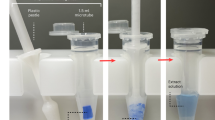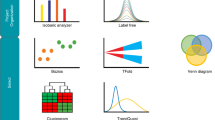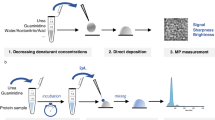Abstract
Tricine–SDS-PAGE is commonly used to separate proteins in the mass range 1–100 kDa. It is the preferred electrophoretic system for the resolution of proteins smaller than 30 kDa. The concentrations of acrylamide used in the gels are lower than in other electrophoretic systems. These lower concentrations facilitate electroblotting, which is particularly crucial for hydrophobic proteins. Tricine–SDS-PAGE is also used preferentially for doubled SDS-PAGE (dSDS-PAGE), a proteomic tool used to isolate extremely hydrophobic proteins for mass spectrometric identification, and it offers advantages for resolution of the second dimension after blue-native PAGE (BN-PAGE) and clear-native PAGE (CN-PAGE). Here I describe a protocol for Tricine–SDS-PAGE, which includes efficient methods for Coomassie blue or silver staining and electroblotting, thereby increasing the versatility of the approach. This protocol can be completed in 1–2 d.
*Note: In the version of the article initially published online, the words “Gel buffer (3x)” were missing in the table on page 18. The error has been corrected in all versions of the article.
This is a preview of subscription content, access via your institution
Access options
Subscribe to this journal
Receive 12 print issues and online access
$259.00 per year
only $21.58 per issue
Buy this article
- Purchase on SpringerLink
- Instant access to full article PDF
Prices may be subject to local taxes which are calculated during checkout


Similar content being viewed by others
Change history
10 August 2006
In the version of the article initially published online, the words “Gel buffer (3x)” were missing in the table on page 18. The error has been corrected in all versions of the article.
References
Laemmli, U.K. Cleavage of structural proteins during assembly of the head of bacteriophage T4. Nature 227, 680–685 (1970).
Schägger, H. & von Jagow, G. Tricine–sodium dodecyl sulfate polyacrylamide gel electrophoresis for the separation of proteins in the range from 1–100 kDalton. Anal. Biochem. 166, 368–379 (1987).
Schägger, H. SDS electrophoresis techniques. in Membrane Protein Purification and Crystallization. A Practical Guide 2nd edn. (eds. Hunte, C., von Jagow, G. & Schägger, H.) 4.85–4.103 (Academic, San Diego, California, 2003).
Hjerten, S. Chromatographic separation according to size of macromolecules and cell particles on columns of agarose suspensions. Arch. Biochem. Biophys. 99, 466–475 (1962).
Rabilloud, T. A comparison between low background silver diammine and silver nitrate protein stains. Electrophoresis 13, 429–439 (1992).
Blum, H., Beier, H. & Gross, H.J. Improved silver staining of plant proteins, RNA and DNA in polyacrylamide gels. Electrophoresis 8, 93–99 (1987).
Rais, I., Karas, M. & Schägger, H. Two-dimensional electrophoresis for the isolation of integral membrane proteins and mass spectrometric identification. Proteomics 4, 2567–2571 (2004).
Renart, J., Reiser, J. & Stark, G.R. Transfer of proteins from gels to diazobenzyloxymethyl-paper and detection with antisera: a method for studying antibody specificity and antigen structure. Proc. Natl. Acad. Sci. USA 76, 3116–3120 (1979).
Kyhse-Andersen, J. Electroblotting of multiple gels: a simple apparatus without buffer tank for rapid transfer of proteins from polyacrylamide to nitrocellulose. J. Biochem. Biophys. Methods 10, 203–209 (1984).
Beisiegel, U. Protein blotting. Electrophoresis 7, 1–18 (1986).
Towbin, H., Staehelin, T. & Gordon, J. Electrophoretic transfer of proteins from polyacrylamide gels to nitrocellulose sheets: procedure and some applications. Proc. Natl. Acad. Sci. USA 76, 4350–4356 (1979).
Acin-Perez, R. et al. Respiratory complex III is required to maintain complex I in mammalian mitochondria. Mol. Cell 13, 805–815 (2004).
Schägger, H. et al. Significance of respirasomes for the assembly/stability of human respiratory chain complex I. J. Biol. Chem. 279, 36349–36353 (2004).
Carrozzo, R. et al. Subcomplexes of human ATP synthase mark mitochondrial biosynthesis disorders. Ann. Neurol. 59, 265–275 (2006).
Griffon, N. et al. Molecular determinants of glycine receptor subunit assembly. EMBO J. 18, 4711–4721 (1999).
Dietmeyer, K. et al. Tom 5 functionally links mitochondrial preprotein receptors to the general import pore. Nature 388, 195–200 (1997).
Jänsch, L., Kruft, V., Schmitz, U.K. & Braun, H.-P. Unique composition of the preprotein translocase of the outer mitochondrial membrane from plants. J. Biol. Chem. 273, 17251–17257 (1998).
Vahsen, N. et al. AIF deficiency compromises oxidative phosphorylation. EMBO J. 23, 4679–4689 (2004).
Schägger, H., Cramer, W.A. & von Jagow, G. Analysis of molecular masses and oligomeric states of protein complexes by blue native electrophoresis and isolation of membrane protein complexes by two-dimensional native electrophoresis. Anal. Biochem. 217, 220–230 (1994).
Arnold, I., Pfeiffer, K., Neupert, W., Stuart, R.A. & Schägger, H. Yeast mitochondrial F1F0-ATP synthase exists as a dimer: identification of three dimer-specific subunits. EMBO J. 17, 7170–7178 (1998).
Schägger, H. & Pfeiffer, K. Supercomplexes in the respiratory chains of yeast and mammalian mitochondria. EMBO J. 19, 1777–1783 (2000).
Pfeiffer, K. et al. Cardiolipin stabilizes respiratory chain supercomplexes. J. Biol. Chem. 278, 52873–52880 (2003).
Schägger, H. & von Jagow, G. Blue native electrophoresis for isolation of membrane protein complexes in enzymatically active form. Anal. Biochem. 199, 223–231 (1991).
Schägger, H. Blue native electrophoresis. in Membrane Protein Purification and Crystallization. A Practical Guide 2nd edn. (eds. Hunte, C., von Jagow, G. & Schägger, H.) 5.105–5.130 (Academic, San Diego, California, 2003).
Wittig, I. & Schägger, H. Advantages and limitations of clear native polyacrylamide gel electrophoresis. Proteomics 5, 4338–4346 (2005).
Wittig, I., Braun, H.-P. & Schägger, H. Blue-native electrophoresis. Nat. Protocols (in the press).
Studier, F.W. Analysis of bacteriophage T7 early RNAs and proteins on slab gels. J. Mol. Biol. 79, 237–248 (1973).
Swank, R.T. & Munkres, K.D. Molecular weight analysis of oligopeptides by electrophoresis in polyacrylamide gel with sodium dodecyl sulfate. Anal. Biochem. 39, 462–477 (1971).
Acknowledgements
This work was supported by the Deutsche Forschungsgemeinschaft, Sonderforschungsbereich 628, Project P13.
Author information
Authors and Affiliations
Corresponding author
Ethics declarations
Competing interests
The author declares no competing financial interests.
Rights and permissions
About this article
Cite this article
Schägger, H. Tricine–SDS-PAGE. Nat Protoc 1, 16–22 (2006). https://doi.org/10.1038/nprot.2006.4
Published:
Issue Date:
DOI: https://doi.org/10.1038/nprot.2006.4
This article is cited by
-
A production platform for disulfide-bonded peptides in the periplasm of Escherichia coli
Microbial Cell Factories (2024)
-
Fractionation of the Caspian sand goby epidermal exudates using membrane ultrafiltration and reversed-phase chromatography: an investigation on bioactivities
Scientific Reports (2024)
-
Genome-wide ATAC-see screening identifies TFDP1 as a modulator of global chromatin accessibility
Nature Genetics (2024)
-
Unveiling antibiofilm potential: proteins from Priestia sp. targeting Staphylococcus aureus biofilm formation
Antonie van Leeuwenhoek (2024)
-
Optimization of three-phase partitioning system for the purification of protease from Calotropis gigantea latex using response surface methodology
Chemical Papers (2024)



